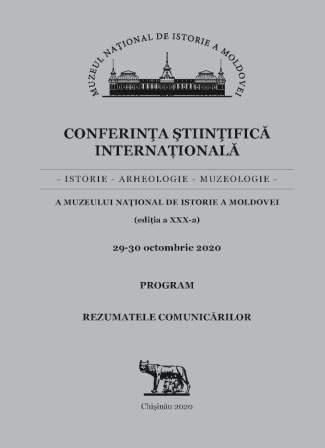  Events Archive Events Archive
XXXth Annual Scientific Conference with International Participation “History. Archeology. Museology” held online
Chișinău, October 29-30, 2020
The annual scientific conference held by the National Museum of History of Moldova over the years has turned into a prestigious forum that brings together famous historians, archaeologists and museographers from the country and abroad. This year's conference communications featured thematic diversity, new methodological approaches, and interdisciplinary research. A significant part of the communications was based on the results of new archaeological investigations, the study of original archival sources, offering new interpretations of known sources.The conference brought together over 90 participants from 10 countries: Moldova, Romania, Ukraine, Poland, Germany, France, Tajikistan, Lithuania, Georgia, and the Russian Federation. During the two days of the conference, 65 communications of researchers from different institutions were heard: from museums (Moldova, Ukraine, Romania, Russian Federation): the National Museum of History of Moldova, the National Museum of Ethnography and Natural History, the Odessa Museum of Archeology (Ukraine), the Moldova National Museum Complex Iaşi (Romania), the Arad Museum Complex, the Vasile Goldiş Western University (Arad), the Kuskovo Museum (Moscow), the Peter the Great Museum of Anthropology and Ethnography (the Kunstkamera) of the Russian Academy of Sciences; from universities (Moldova, Germany, Russian Federation, Romania, Poland, France, Georgia): the Moldova State University, the Ion Creangă State University, Freie Universität Berlin (Germany), the Southern Federal University in Rostov-on-Don (Russian Federation), the Wallachia University of Târgovişte (Romania), Université Sorbonne, Paris (France), the University of Bucharest, the Alexandru Ioan Cuza University of Iaşi, the Jagiellonian University, Kraków (Poland), the West University of Timişoara, the Tbilisi State University (Georgia), the Don State Technical University, Rostov-on-Don (Russian Federation), the St. Petersburg University of the Ministry of Internal Affairs of Russia (Russian Federation), the Saint Petersburg State University (Russian Federation), and other academic institutions (Moldova, Russian Federation, Romania, Lithuania, Tajikistan: the Institute of History of the Ministry of Education, Culture and Research, the Institute of Archeology of the Romanian Academy Iaşi Branch), the Olga Necrasov Center for Anthropological Research of the Romanian Academy (Iaşi Branch) (Romania), the Institute of Archeology of the Russian Academy of Sciences (Russian Federation), the N.N. Miklouho-Maclay Institute of Ethnology and Anthropology of the Russian Academy of Sciences (Moscow), the Lithuanian Institute of History, Vilnius (Lithuania), the Faculty of Philosophy of the Oryol State University (Russian Federation), the A. Donish Institute of History, Archeology and Ethnography of the National Academy of Sciences of Tajikistan, the Center for Written Heritage of the Academy of Sciences of the Republic of Tajikistan, the Institute of Slavic Studies of the Russian Academy of Sciences (Moscow, Russia), the Institute of World History of the Russian Academy of Sciences (Moscow, Russia). The full program of the conference can be found here. We express our gratitude to all the participants of this conference.
|
 31 August 1989 St., 121 A, MD 2012, Chisinau, Republic of Moldova
31 August 1989 St., 121 A, MD 2012, Chisinau, Republic of Moldova























































